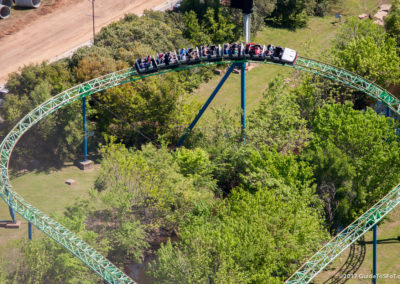Shock Wave
Shock Wave is a classic, steel looping roller coaster added to the Tower section of Six Flags over Texas in 1978. When the ride opened it was the tallest, continuous-circuit coaster in the world. Shock Wave remains one of the few looping coasters with simple lap bars for restraints (as opposed to over-the-shoulder harnesses).
Though it may look tame compared to some of today’s rides, Shock Wave is easily one of the most intense coasters in the world. It produces serious G-forces, both positive and negative. The consecutive loops are circular instead of the ellipticalTechnically modern loops are clothoid-shaped shape used for most loops, producing up to 6 Gs. At the opposite end of the force spectrum, Shock Wave’s multiple hills provide powerful airtime, a rare feature on an inverting coaster.
Shock Wave’s location alongside Interstate 30 reportedly caused a few highway wrecks when it first opened due to distracted drivers.
Retro Roller Coaster
A train speeds down the first drop with the ride’s classic sign in the foreground
High-Force Loop
Shock Wave’s nearly circular loops are known for providing intense G-forces (up to 5.9)
Lift Hill Supports
Shock Wave’s lift hill supports do the splits due to Johnson Creek being directly underneath
Airtime Hill
Although most inverting coasters aren’t known for giving airtime, Shock Wave’s hills have several strong pops of negative G’s
Double Loops
Shock Wave’s consecutive loops reportedly caused numerous automobile accidents due to distracted drivers along Interstate 30 (immediately behind the ride)
Ongoing Rehabilitation
Shock Wave has thrilled guests of Six Flags over Texas for over 45 years, but the ride has essentially outlived the expected operational life for which it was designed. Instead of removing the ride, the park has decided to invest in its historical significance. Shock Wave is occasionally closed for annual rehabilitation on the ride’s track, so be sure to check its status before visiting if it’s a priority for you.
Technical Details
Though often credited to Schwarzkopf, Shock Wave was actually designed by Werner Stengel, a prolific German engineer that has worked on countless modern coasters. Anton Schwarzkopf’s company handled the manufacturing and technical details of the ride.
Shock Wave’s track uses a rigid, four-sided lattice design that minimizes the supports needed due to its inherent strength. The supports are also known for their skinny, toothpick-like look. They taper down to a sphere-shaped end near their base and interlock with a socket in each footer, forming an innovative ball-and-socket connection (similar to La Vibora). Instead of creating a rigid connection between the support and footer, the design allows relative motion reducing stress. The design also results in track that sways more than the average coaster as trains pass by, furthering the illusion of danger. Guy wires attached to various sections of track add stability.
Shock Wave Trivia
Shock Wave's Sister
A Colorful Past
Shock Wave Stats
| Ride Type: | Steel looping coaster |
| Height: | 116 ft |
| Top Speed: | 60 mph |
| Length: | 3600 ft |
| Year Introduced: | 1978 |
| Inversions: | 2 |
| Manufacturer: | Schwarzkopf |
| Duration: | 2 min |
| Height Requirement: | 42 in |
| Status: | Operating |
| Flash Pass Enabled: | No |
Live Wait Time
Shock Wave is currently closed.
Powered by Queue-Times.com
Where to Sit?
Sit in the back for the most powerful airtime throughout the ride. And try looking out to the side during the loops to literally watch the world turn upside down.













0 Comments